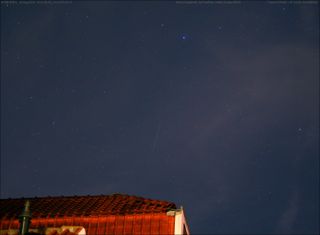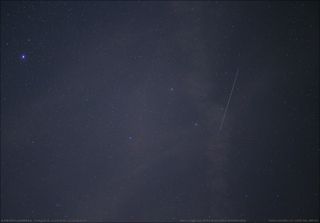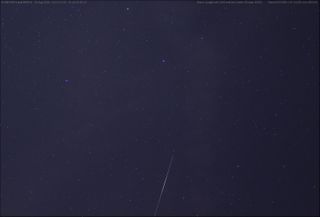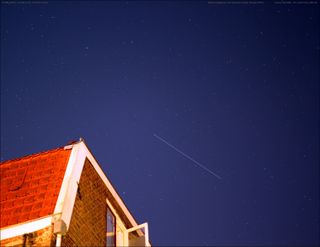Gotcha! US Air Force's Secretive X-37B Space Plane Spotted by Satellite Tracker

The U.S. Air Force's X-37B space plane may be secretive, but it's not invisible.
Netherlands-based satellite tracker Marco Langbroek snapped long-exposure photos of the robotic mini-shuttle zooming over the city of Leiden yesterday (Aug. 20), capturing the spacecraft's rapid trek across the night sky as a thin streak of light.
The Air Force discloses little about X-37B missions, keeping details about the plane's orbit and most of its payloads close to the vest. But Langbroek said he's confident that the light trail he photographed came from the space plane, which is also known as the Orbital Test Vehicle (OTV). [The X-37B Space Plane: 6 Surprising Facts]

"The object in question is not in the public catalogue of satellite orbits maintained by JSpOC (the U.S. military tracking network), which shows for an object this bright that it must be a 'classified' object," Langbroek told Space.com via email. "We nevertheless know where 'classified' objects like this are, because they are routinely tracked by a small network of amateur trackers, in which I takepart."
The object he photographed last night is in a very low orbit, Langbroek added: between 193 miles and 202 miles (310 to 325 kilometers). (For comparison, the International Space Station's average altitude is about 250 miles, or 400 km.) And the object actively maneuvers from time to time, so it can't be some piece of space junk about to re-enter Earth's atmosphere.

"Basically, only one type of object fits this: X-37B," Langbroek said. "Previous X-37B missions we tracked also orbited at such very low altitudes. The object also has a similar brightness to previous OTV missions."
And to really seal the deal, when you project this object's orbital plane backward in time, it passes right over Florida's Cape Canaveral Air Force Station at around 10 a.m. EDT (1400 GMT) on Sept. 7, 2017 — right when a SpaceX Falcon 9 rocket lofted the X-37B on its current mission, called OTV-5.
Get the Space.com Newsletter
Breaking space news, the latest updates on rocket launches, skywatching events and more!
The X-37B looks like a miniature version of NASA's now-retired space shuttle orbiter. The Air Force is known to possess two OTVs, both of which were built by Boeing. Each vehicle is 29 feet (8.8 meters) long and 9.6 feet (2.9 m) tall, with a payload bay the size of a pickup truck bed.
As its name suggests, OTV-5 is the fifth X-37B mission. To date, each OTV flight has spent more time in orbit than the last. OTV-1 launched in April 2010 and spent 224 days in space; OTV-2 began in March 2011 and logged 468 days in space; OTV-3 zipped around Earth for nearly 675 days after its December 2012 liftoff, and OTV-4 launched in May 2015 and landed 718 days later, in May 2017.
X-37B OTV 5 on 20 AUG 2018 from Marco Langbroek on Vimeo. (The short movie above was captured using a WATEC 902H CCTV camera equipped with an old Canon FD 1.8/50 mm lens, Langbroek said.)
Air Force officials have said that the X-37B is testing reusable-spaceflight technology and gear for future spacecraft on these missions. Experts have said this explanation makes sense, dismissing claims that the OTV may be a space weapon of some sort.
Oh, and you can spot the X-37B overhead as well, if you know where to look, Langbroek said. The spacecraft is usually quite bright — often bright enough to be naked-eye visible from the middle of Leiden, he added. (For tips on where to look, go to satellite-tracking sites such as Heavens Above or N2YO.)
"During favorable passes, the spacecraft reaches magnitude +1, which is brighter than, for example, the stars of the Big Dipper and similar to the brightness of Saturn or Mars in the sky," Langbroek said. "It is easily visible to the naked eye then, even from the urban town center I observe from."

Last night's pass wasn't even a particularly great one, he added. And he still used "very simple equipment: a normal DSLR (a Canon EOS 60D) with a Canon EF F2.0/35mm wide-angle lens, on a normal camera tripod. The camera was set on ISO 800, the lens wide open at F2.0, and I used an exposure time of 5 seconds."
Follow Mike Wall on Twitter @michaeldwall and Google+. Follow us @Spacedotcom, Facebook or Google+. Originally published on Space.com.
Join our Space Forums to keep talking space on the latest missions, night sky and more! And if you have a news tip, correction or comment, let us know at: community@space.com.

Michael Wall is a Senior Space Writer with Space.com and joined the team in 2010. He primarily covers exoplanets, spaceflight and military space, but has been known to dabble in the space art beat. His book about the search for alien life, "Out There," was published on Nov. 13, 2018. Before becoming a science writer, Michael worked as a herpetologist and wildlife biologist. He has a Ph.D. in evolutionary biology from the University of Sydney, Australia, a bachelor's degree from the University of Arizona, and a graduate certificate in science writing from the University of California, Santa Cruz. To find out what his latest project is, you can follow Michael on Twitter.